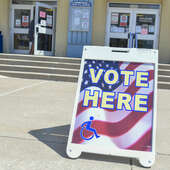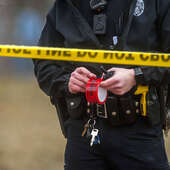More to explore
-
 Local News 7/22/24Fall Tunes at Twilight performance series set to kick off next weekOld Town Cape has released the lineup for the fall series of Tunes at Twilight — cooler weather, hopefully fewer bugs and an earlier start time for each show. The fall series will begin at 6:30 p.m. Friday, Aug. 2, at Ivers Square in downtown Cape...
Local News 7/22/24Fall Tunes at Twilight performance series set to kick off next weekOld Town Cape has released the lineup for the fall series of Tunes at Twilight — cooler weather, hopefully fewer bugs and an earlier start time for each show. The fall series will begin at 6:30 p.m. Friday, Aug. 2, at Ivers Square in downtown Cape... -
 Local News 7/22/24Former Secret Service agent, Cape native shares thoughts on Trump assassination attemptFormer Secret Service agent Paul Nenninger — a native of Cape Girardeau who has served on the Cape Girardeau Public Schools Board of Education — weighed in with thoughts about the attempted assassination of former President Donald Trump on Saturday,...
Local News 7/22/24Former Secret Service agent, Cape native shares thoughts on Trump assassination attemptFormer Secret Service agent Paul Nenninger — a native of Cape Girardeau who has served on the Cape Girardeau Public Schools Board of Education — weighed in with thoughts about the attempted assassination of former President Donald Trump on Saturday,... -

-

-

-
 Local News 7/19/24A massive tech outage is causing worldwide disruptions. Here's what we know.11NEW YORK (AP) — Much of the world faced online disarray Friday as a widespread technology outage affected companies and services across industries — grounding flights, knocking banks and hospital systems offline and media outlets off air. At the...
Local News 7/19/24A massive tech outage is causing worldwide disruptions. Here's what we know.11NEW YORK (AP) — Much of the world faced online disarray Friday as a widespread technology outage affected companies and services across industries — grounding flights, knocking banks and hospital systems offline and media outlets off air. At the... -
 Local News 7/19/24Time for school vaccines as state sees exemption rates rise, immunization rates fall9The weeks before the start of school are some of the busiest for the Cape Girardeau County Health Department. Health professionals are busy giving an estimated 1,900 vaccines to schoolchildren. These vaccines are required for school attendance. But...
Local News 7/19/24Time for school vaccines as state sees exemption rates rise, immunization rates fall9The weeks before the start of school are some of the busiest for the Cape Girardeau County Health Department. Health professionals are busy giving an estimated 1,900 vaccines to schoolchildren. These vaccines are required for school attendance. But... -
 Local News 7/19/24From Oak Ridge to national cow fame: How a young farmer and his cow became 'Cream of the Crop'4Kelby Schoen, a 13-year-old dairy farmer from Oak Ridge, received the prestigious "Cream of the Crop" award in Salt Lake City at the National Holstein Convention last month. His cow, MayBell, was ranked in the top 10 in the country for butterfat and...
Local News 7/19/24From Oak Ridge to national cow fame: How a young farmer and his cow became 'Cream of the Crop'4Kelby Schoen, a 13-year-old dairy farmer from Oak Ridge, received the prestigious "Cream of the Crop" award in Salt Lake City at the National Holstein Convention last month. His cow, MayBell, was ranked in the top 10 in the country for butterfat and... -

-

-

-

-

-

-
 Local News 7/19/24Guardrail repairs on NB U.S. 61, SB I-55 in Cape Girardeau CountyNorthbound U.S. 61 in Cape Girardeau County, at the intersection of Kingshighway and Independence Street in Cape Girardeau, will be reduced to one lane with a 12-foot width restriction as contractor crews perform overnight guardrail repairs. ...
Local News 7/19/24Guardrail repairs on NB U.S. 61, SB I-55 in Cape Girardeau CountyNorthbound U.S. 61 in Cape Girardeau County, at the intersection of Kingshighway and Independence Street in Cape Girardeau, will be reduced to one lane with a 12-foot width restriction as contractor crews perform overnight guardrail repairs. ... -

-
 Local News 7/18/24Cape Girardeau Gun Violence Task Force members announced; first meeting set for Tuesday27Members of the City of Cape Girardeau’s newly formed Gun Violence Task Force will gather for the first time next week. The task force has sent out its first agenda and will have its planning meeting at 5:30 p.m. Tuesday, July 23, at City Hall. ...
Local News 7/18/24Cape Girardeau Gun Violence Task Force members announced; first meeting set for Tuesday27Members of the City of Cape Girardeau’s newly formed Gun Violence Task Force will gather for the first time next week. The task force has sent out its first agenda and will have its planning meeting at 5:30 p.m. Tuesday, July 23, at City Hall. ... -
 Local News 7/18/24Cape Girardeau area leaders encourage gun locks, security measures3Gun violence has captured the attention and worry of people in and around Cape Girardeau. The shooting that left two injured at Cape Central High School’s graduation ceremony in May fueled bubbling grassroots awareness efforts. ...
Local News 7/18/24Cape Girardeau area leaders encourage gun locks, security measures3Gun violence has captured the attention and worry of people in and around Cape Girardeau. The shooting that left two injured at Cape Central High School’s graduation ceremony in May fueled bubbling grassroots awareness efforts. ... -
 Local News 7/18/24Jackson aldermen updated on wastewater facility projectThe Jackson mayor and Board of Aldermen heard various reports at its Monday, July 15, meeting, including on a wastewater project and new businesses in town. Ed Sewing presented on the Jackson Wastewater Treatment Facility Improvements Project, which...
Local News 7/18/24Jackson aldermen updated on wastewater facility projectThe Jackson mayor and Board of Aldermen heard various reports at its Monday, July 15, meeting, including on a wastewater project and new businesses in town. Ed Sewing presented on the Jackson Wastewater Treatment Facility Improvements Project, which... -
 Local News 7/18/24Cape Girardeau County Commission agenda for 7/18/24 meetingCape Girardeau County Commission 9 a.m. Thursday, July 18, 1 Barton Square, Jackson Approval of minutes n Approval of minutes of the Monday, July 8, meeting Communications/reports — other selected officials/department heads n Updates on new jail and...
Local News 7/18/24Cape Girardeau County Commission agenda for 7/18/24 meetingCape Girardeau County Commission 9 a.m. Thursday, July 18, 1 Barton Square, Jackson Approval of minutes n Approval of minutes of the Monday, July 8, meeting Communications/reports — other selected officials/department heads n Updates on new jail and... -

-

-

-

-

-
 Most read 7/16/24Local legislators, candidates react to Trump rally shooting10Political division continues to increase in the United States as both sides of the political aisle point fingers at one another in the wake of the recent attempted assassination of former President Donald Trump. Trump was injured after 20-year-old...
Most read 7/16/24Local legislators, candidates react to Trump rally shooting10Political division continues to increase in the United States as both sides of the political aisle point fingers at one another in the wake of the recent attempted assassination of former President Donald Trump. Trump was injured after 20-year-old... -
 Most read 7/16/24Trump picks Sen. JD Vance of Ohio as GOP running mate19MILWAUKEE — Former President Donald Trump chose Sen. JD Vance of Ohio as his running mate Monday, picking a onetime critic who became a loyal ally and is now the first millennial to join a major-party ticket at a time of deep concern about the...
Most read 7/16/24Trump picks Sen. JD Vance of Ohio as GOP running mate19MILWAUKEE — Former President Donald Trump chose Sen. JD Vance of Ohio as his running mate Monday, picking a onetime critic who became a loyal ally and is now the first millennial to join a major-party ticket at a time of deep concern about the... -
 Most read 7/16/24Cape County coroner candidates speak out at women’s club meeting3Candidates for the Cape Girardeau County coroner position met with potential voters during the Cape County Republican Women’s Club meeting Friday, July 12, at Delmonico’s Steakhouse in Jackson. Three of the six coroner candidates spoke at the...
Most read 7/16/24Cape County coroner candidates speak out at women’s club meeting3Candidates for the Cape Girardeau County coroner position met with potential voters during the Cape County Republican Women’s Club meeting Friday, July 12, at Delmonico’s Steakhouse in Jackson. Three of the six coroner candidates spoke at the... -
 Most read 7/16/24Cape County Coroner Jordan reveals civil attorney won’t take case in answer filed to judge18Judge Jerel Poor denied a request to seal an answer made by Wavis Jordan regarding his ability to obtain a civil attorney, with Jordan stating, “a civil attorney won’t take my case” and requesting his answer be sealed from “news media”. Jordan was...
Most read 7/16/24Cape County Coroner Jordan reveals civil attorney won’t take case in answer filed to judge18Judge Jerel Poor denied a request to seal an answer made by Wavis Jordan regarding his ability to obtain a civil attorney, with Jordan stating, “a civil attorney won’t take my case” and requesting his answer be sealed from “news media”. Jordan was... -
 Most read 7/16/24Cape Girardeau shooting victim identified4A Cape Girardeau man died early Sunday, July 14, after being shot in the 400 block of Broadway in Cape Girardeau, authorities said. A release from the Cape Girardeau/Bollinger County Major Case Squad says Linard Thomas, 42, arrived at a local...
Most read 7/16/24Cape Girardeau shooting victim identified4A Cape Girardeau man died early Sunday, July 14, after being shot in the 400 block of Broadway in Cape Girardeau, authorities said. A release from the Cape Girardeau/Bollinger County Major Case Squad says Linard Thomas, 42, arrived at a local... -
 Most read 7/15/24One killed early Sunday in Cape Girardeau9A person died early Sunday, July 14, after being shot in the 400 block of Broadway in Cape Girardeau, authorities said. A release from the Cape Girardeau/Bollinger County Major Case Squad says the subject arrived at a local hospital with a...
Most read 7/15/24One killed early Sunday in Cape Girardeau9A person died early Sunday, July 14, after being shot in the 400 block of Broadway in Cape Girardeau, authorities said. A release from the Cape Girardeau/Bollinger County Major Case Squad says the subject arrived at a local hospital with a... -
 Most read 7/15/24Two Jackson men arrested with weapons 'capable of lethal force' after apparent attempt to enter Cape business7Two Jackson men have each been charged with several felonies in connection with an incident in which both were found with weapons deemed to be capable of lethal force. A release from Cape Girardeau Police Department says police responded about 12:30...
Most read 7/15/24Two Jackson men arrested with weapons 'capable of lethal force' after apparent attempt to enter Cape business7Two Jackson men have each been charged with several felonies in connection with an incident in which both were found with weapons deemed to be capable of lethal force. A release from Cape Girardeau Police Department says police responded about 12:30...




Respond to this story
Posting a comment requires a subscription.